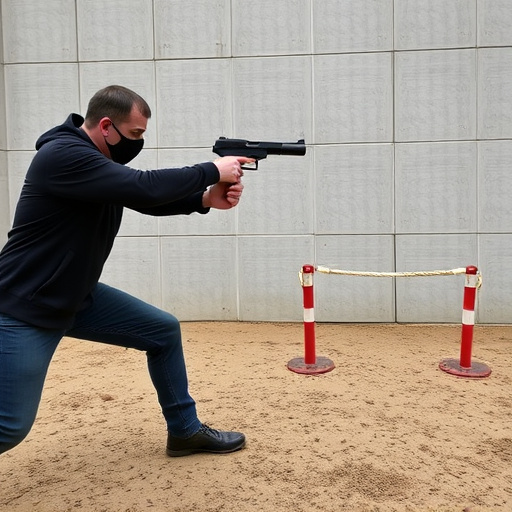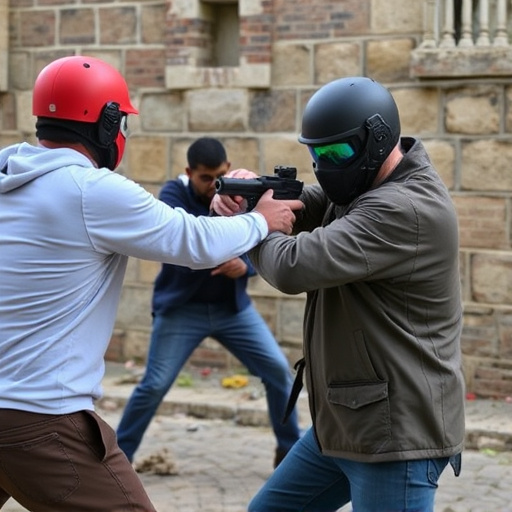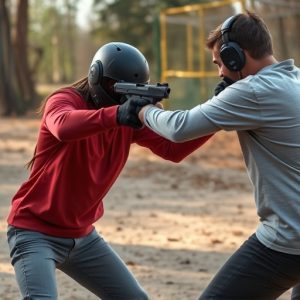Most Powerful Legal Stun Weapons: Demystifying Intimidation Factors
Electrical arc displays, like tasers and stun guns, are among the most powerful legal self-defense t…….
Electrical arc displays, like tasers and stun guns, are among the most powerful legal self-defense tools available. They use high-voltage, low-current electrical shocks to temporarily incapacitate aggressors, deterring them without causing permanent harm. As a game-changer in personal safety, these devices harness the human mind's fear response, enabling individuals to overcome physical and psychological threats. However, their effectiveness varies, and their legal status globally differs, with some regions allowing open carry while others restrict them to law enforcement. Prospective buyers should consider device quality, user proficiency, and local laws when choosing among the most powerful legal stun weapons.
“Uncover the captivating yet intimidating world of Electrical Arc Displays, a phenomenon that has sparked curiosity and fear. This article delves into the science behind these displays, exploring their significant intimidation factor. We present a comprehensive guide to ‘Most Powerful Legal Stun Weapons’, examining advanced tools designed for self-defense. Understanding the psychology of fear is crucial in this context, as it shapes our perception of safety. Additionally, legal considerations surrounding stun devices are dissected, ensuring informed decisions. Get ready to demystify stun guns, uncover their effectiveness, and explore why they are among the most powerful legal stun weapons available.”
- Understanding Electrical Arc Display: The Science Behind the Intimidation
- Most Powerful Legal Stun Weapons: A Comprehensive Overview
- The Psychology of Fear and Its Role in Self-Defense
- Legal Considerations and Regulations for Stun Devices
- Demystifying Stun Guns: How They Work and Their Effectiveness
Understanding Electrical Arc Display: The Science Behind the Intimidation

Electrical arc displays, often referred to as stun weapons, are among the most powerful legal self-defense tools available. The intimidation factor comes from the science behind their operation. These devices produce a high-voltage, low-current electrical discharge, typically in the form of an arc, which can temporarily incapacitate a target by disrupting the normal functioning of their nervous system.
The arc is generated by a gap between two electrodes, usually created through a mechanical or electronic mechanism. When activated, an intense electric current jumps across this gap, creating a bright flash and a powerful shockwave. This sudden and intense energy delivery can cause muscular contractions, disorientation, and even temporary paralysis, making it an effective deterrent against potential threats. The design and functionality of these devices are tailored to ensure they remain legal while maximizing their intimidation value, thus serving as formidable personal defense tools for individuals seeking protection.
Most Powerful Legal Stun Weapons: A Comprehensive Overview

In the realm of self-defense, the search for effective yet legal deterrents has led many to explore the capabilities of what are commonly referred to as the most powerful legal stun weapons. These devices, designed to temporarily incapacitate an aggressor without causing permanent harm, have gained significant traction among individuals seeking personal safety. One of the key advantages lies in their legality, ensuring users can employ them without facing legal repercussions, unlike firearms or other restricted weapons.
The market offers a diverse range of stun guns, tasers, and stun batons, each boasting impressive electrical arc display capabilities. Tasers, for instance, deliver powerful electrical pulses that disrupt muscle control, rendering the target temporarily immobilized. Stun guns, often resembling traditional firearms, utilize high-voltage, low-current electricity to cause a severe shock, deterring potential assailants. Furthermore, stun batons combine the versatility of a self-defense tool with the power of an electric arc, offering users a tactical advantage in close-quarters encounters.
The Psychology of Fear and Its Role in Self-Defense

The human mind is an intricate web of emotions, and fear is one of the most primal responses we possess. When faced with a potential threat, our bodies release adrenaline, preparing us for action through increased heart rate, heightened senses, and rapid reflexes. This fight-or-flight response is an evolutionary adaption that has saved countless lives over time. In today’s world, understanding fear and its triggers is crucial, especially in self-defense scenarios where the right tools can make all the difference.
In terms of self-protection, recognizing and leveraging our natural instincts can be a game-changer. The psychological impact of being intimidated by a perceived danger can often be as powerful as the physical threat itself. This is why many individuals turn to legal stun weapons, considered among the most effective personal defense tools available. These devices, such as stun guns or tasers, are designed to overcome an assailant’s strength and fear through electric shocks, temporarily disabling them to allow for escape or additional help. Understanding the psychology of fear and its role in self-defense empowers individuals to take control and protect themselves effectively.
Legal Considerations and Regulations for Stun Devices

In many countries, the possession and use of stun devices are subject to strict regulations due to their potential as both self-defense tools and weapons of harm. The legal considerations surrounding stun guns or electroshock weapons vary widely globally, with some regions allowing their open carry while others restrict them to law enforcement agencies only. These variations often depend on factors like public safety, crime rates, and the specific capabilities of the devices.
When discussing the most powerful legal stun weapons, it’s crucial to understand that power isn’t just measured in joules or voltage; it also includes the device’s effectiveness, range, and the jurisdiction’s laws governing its use. Some countries permit high-voltage stun guns for personal protection while adhering to strict guidelines on when and where they can be deployed. These regulations aim to balance individual rights with public safety, ensuring that citizens have access to legal self-defense options while preventing misuse.
Demystifying Stun Guns: How They Work and Their Effectiveness

Stun guns, also known as electric shock weapons, have long been a topic of intrigue and debate due to their intimidating display and reported effectiveness in incapacitating individuals. These devices work by delivering a powerful electrical current through two metal probes, causing severe muscle contractions and temporary paralysis. The most powerful legal stun weapons on the market today use high voltage and low amperage to ensure maximum shock potential while adhering to legal limitations.
While often considered game changers for personal defense, the effectiveness of stun guns is contingent on various factors, including the user’s training, the device’s quality, and the target’s physical attributes. Despite their intimidating nature and claims of instant incapacitation, studies suggest that the success rate may not always be as guaranteed as manufacturers suggest. As such, prospective users should approach stun guns with an understanding of their limitations and consider them as one component of a comprehensive self-defense strategy.
In exploring the intersection of science, psychology, and law surrounding electrical arc displays and stun devices, it’s evident that understanding their true capabilities is paramount. While the intimidation factor associated with these tools can be significant, demystifying their function and evaluating their effectiveness under legal scrutiny is crucial for informed decisions regarding self-defense. When considering the most powerful legal stun weapons available, a balanced approach—combining knowledge, caution, and adherence to regulations—is essential for ensuring safety and responsible use.


